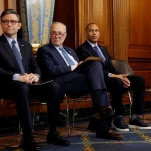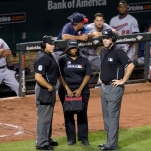What We Haven't Learned From the Steubenville Rape Case


The picture is still one of the first things that comes up when you search “Steubenville rape case.” The girl is a blur of pixelation, but you can see where her shirt lifts to expose her stomach and lower back. There are two boys carrying her by her wrists and ankles, and her head is slung back toward the floor at an extreme angle. A third boy in white mesh shorts looks on from the left of the frame.
What happened in Steubenville, Ohio on the night of August 11, 2012, would become public in pieces, and this image was one of the first to spread online. Other photos like it were posted to Instagram, tweeted by teens with 10 or 12 followers, and shared among the amorphous social circles that tend to exist in high school.
The victim, a 16-year-old girl who had come to Steubenville that night from a nearby town in West Virginia, had become so intoxicated that she was described as “sleeping” by witnesses who watched her being moved from party to party by Trent Mays, a 16-year-old player on the town’s revered high school football team, and Ma’lik Richmond—also 16, also a star player for Big Red. Throughout the night, they penetrated her unconscious body with their fingers while their friends took videos and laughed. The victim would learn what was done to her, according to her mother, by reading about it on social media and in the local paper.
The details of what happened next feel familiar to me now, because they have happened again like this in the years since: The rape was reported and the small town split its loyalties. A Big Red volunteer coach told The New York Times that the girl’s rape claim had been an “excuse” to cover her own bad behavior. “What else are you going to tell your parents when you come home drunk like that and after a night like that?” said Nate Hubbard, who was 27 at the time and one of the team’s 19 coaches. “She had to make up something. Now people are trying to blow up our football program because of it.” Others in the town, speaking anonymously for fear of retribution, told the Times that football players acted with impunity and they hoped someone would be held accountable.
Mays and Richmond were eventually charged and convicted of rape, a rarity in this country. They were sentenced to juvenile detention, where Richmond served for about a year, and Mays for nearly two. It was around this same time that I started my first job in journalism, which is maybe why the story felt so big to me. It seemed to be everywhere—media personalities from Nancy Grace to Roseanne Barr had staked a position, a CNN reporter mourned the boys’ stolen futures, and Anonymous held protests near the small town’s courthouse. The saturation of coverage in my particular bubble made it feel like some kind of tipping point—a case that, because of the involvement of social media, had made the kinds of routine violence and degradation girls and women experience something that couldn’t be ignored. There was nowhere, it seemed, to avert our gazes.
The answer, like most things related to sexual assault, is complicated.
“I remember the case because it was one of the first I noticed, the first one I really heard about and followed,” said Cat Woodbury, a 23-year-old from Massachusetts who was in her first year of college when news of the Steubenville case broke nationally. “[The victim] was so close to my own age.”
Like most high school students, Woodbury never learned about consent in her high school health class. “I remember it was more about preventing pregnancies and STDs,” she told me. Which is also why the case was the first time she thought of rape as something that could happen within a peer group: “Before then, I thought of it as more like strangers attacking people, not really people you would know.”
-

-

-

-

-

-

-

-

-

-

-

-

-

-

-

-

-

-

-

-

-

-

-

-

-

-

-

-

-

-

-

-

-

-

-

-

-

-

-

-

-

-

-

-

-

-

-

-

-

-

-

-

-

-

-

-

-

-

-

-

-

-

-

-

-

-

-

-

-

-

-

-

-

-

-

-

-

-

-

-

-

-

-

-

-

-

-

-

-

-

-

-

-

-

-

-

-

-

-

-

-

-

-

-

-

-

-

-












































































































